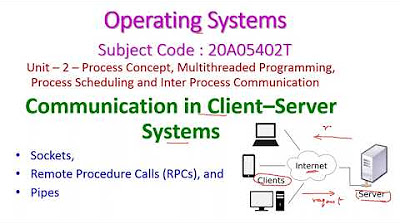Remote Procedure Calls (RPC)
Summary
TLDRThis lecture delves into Remote Procedure Calls (RPC), contrasting it with Inter-Process Communication (IPC). RPC facilitates communication between processes on different systems over a network, abstracting network details from the processes. It operates on a message-passing system, where messages are well-structured and include function identifiers and parameters. The lecture explains the role of RPC daemons, parameter marshalling, and the use of stubs on both client and server sides to hide communication complexities. It sets the stage for the next lecture, which will address challenges faced by RPC and their solutions.
Takeaways
- 🌐 **Remote Procedure Calls (RPC)**: RPC is a protocol that allows a program to request a service from another program located in a different computer or network without understanding the network's details.
- 💬 **Communication Between Systems**: RPC is used when processes in different systems connected over a network need to communicate with each other.
- 🔗 **Similarity to IPC**: RPC is similar to Inter-Process Communication (IPC) but is designed for processes executing on separate systems.
- 📦 **Message-Based Communication**: Unlike shared memory in IPC, RPC uses a message-based communication scheme because processes are on different systems.
- 📨 **Structured Messages**: Messages in RPC are well-structured and contain an identifier of the function to execute and parameters, unlike simple data packets in IPC.
- 📡 **RPC Daemon**: Each RPC message is addressed to an RPC daemon listening on a port on the remote system, which is always waiting for incoming requests.
- 🛠️ **Function as a Service**: In RPC, a function is considered a service that can be requested by one process from another, requiring the passing of parameters and potential return values.
- 🔄 **Parameter Marshalling**: Parameters are packaged into a form that can be transmitted over a network, which is a critical step in the RPC process.
- 🔄 **Message Passing**: The stub on the client side transmits a message to the server, which is received by a server-side stub to invoke the procedure.
- 🔙 **Return Values**: After a function is executed on the server, any return values are passed back to the client using the same message passing technique.
Q & A
What is the main focus of the lecture?
-The lecture focuses on remote procedure calls (RPC), which are used for communication between processes residing in different systems connected over a network.
How does RPC differ from local process communications?
-RPC differs from local process communications by enabling communication between processes that are located on separate systems connected via a network.
What is the role of a network in the context of RPC?
-In the context of RPC, the network connects different systems where processes reside and facilitates communication between them.
Why is message passing used in RPC instead of shared memory?
-Shared memory is not feasible in RPC because processes are in different systems. Therefore, message passing is used as the communication scheme.
What is the purpose of an RPC daemon?
-An RPC daemon is a program that always listens on a port on the remote system, waiting to receive incoming requests and execute the corresponding functions.
How are messages structured in RPC communications?
-Messages in RPC communications are well-structured and contain an identifier of the function to execute and the parameters to pass to that function.
What is a stub in the context of RPC?
-A stub in the context of RPC is a piece of code on the client side that hides the communication details from the client and facilitates the invocation of remote procedures.
What happens when a client invokes a remote procedure?
-When a client invokes a remote procedure, the RPC system calls the appropriate stub, which then locates the server's port and marshals the parameters before sending the message.
What is parameter marshalling?
-Parameter marshalling is the process of packaging parameters into a form that can be transmitted over a network for remote procedure calls.
How are return values from a remote procedure communicated back to the client?
-Return values from a remote procedure are communicated back to the client using the same message passing technique that was used to send the initial request.
What issues might arise in RPC and how are they addressed?
-Issues in RPC can include network latency, security concerns, and data serialization/deserialization problems. These issues are addressed in subsequent lectures.
Outlines

此内容仅限付费用户访问。 请升级后访问。
立即升级Mindmap

此内容仅限付费用户访问。 请升级后访问。
立即升级Keywords

此内容仅限付费用户访问。 请升级后访问。
立即升级Highlights

此内容仅限付费用户访问。 请升级后访问。
立即升级Transcripts

此内容仅限付费用户访问。 请升级后访问。
立即升级浏览更多相关视频

Communication in Client–Server Systems-Operating Systems-Unit-2-20A05402T

Issues in RPC & How They're Resolved

Inter Process Communication | Introduction | Part-1/2 | OS | Lec-38 | Bhanu Priya

Linux Internals : Interprocess Communication

Interprocessor Communication and Syncronization (Computer Architecture)

Remote Procedure Call (RPC) - IOT - Pascasarjana STMIK Handayani
5.0 / 5 (0 votes)
